7. EXPANSION ... AND DIVISION

JAMES POLK AND THE MEXICAN-AMERICAN WAR
CONTENTS
 The 1844 elections The 1844 elections
 The Mexican-American War The Mexican-American War
(1846-1848)
 The moral impact of the Mexican- The moral impact of the Mexican-
American War
The textual material on this webpage is drawn directly from my work
America – The Covenant Nation © 2021, Volume One, pages 253-259.
A Timeline of Major Events during this period
| 1840s |
The Mexican-American War
1845 As outgoing President (Polk had just won the 1844 election), Tyler pushed Congress to invite Texas to become part
of the Federal Union; Texas agrees (Dec) ... infuriating Mexico
1846 Texas-Mexico border questions greatly complicate the issue (troops from both sides moving into the border
region) and finally Polk gets Congress to declare war (May)
Americans
are quick to seize Mexican lands West to the Pacific Ocean (June)
Then
General Zacharly Taylor moves his troops into Mexico ... joined by
Winfield Scott's troops
1847 American troops are able to enter Mexico City (Sep) as Santa Anna flees; the war is over
1848 America agrees (Jan – The Guadalupe Treaty) to pay Mexico $15 million for Texas and the Western lands America now possesses ... resolving the issue somewhat
|
|
The 1844 elections: Clay vs. Polk, vs. Birney.
In the 1844 elections, the Whig nominee Clay found
himself up against the Democrat (Tennessean) James Polk. President Van
Buren had alienated so many within his own Democratic Party that the
party's presidential nomination ultimately had gone to Polk, something
of a dark horse that had not been one of the early frontrunners in the
party. Polk subsequently ran his campaign on the promise that if
elected he would admit both Texas and Free-Soil (no slavery allowed)
Oregon as new states, thus offsetting some of the northern opposition
to the admission of Texas as a slave state.
Clay, his third time as a presidential
candidate, ran on the typical Whig platform of Clay's own American
System: protective tariffs to promote American industry, a strong
central bank, and the building of the commercial infrastructure of
canals and roads. These all tended to favor the conservative interests
of the up-East financial-industrial class, and undercut his support
among Westerners and Southerners.
But a "third-party-spoiler," the Liberal
Party's James Birney, was also running, drawing support away from those
who otherwise would have voted for Clay. This would prove ruinous for
Clay. So it was that Polk handily won the electoral vote, including
even a large number of northern states.
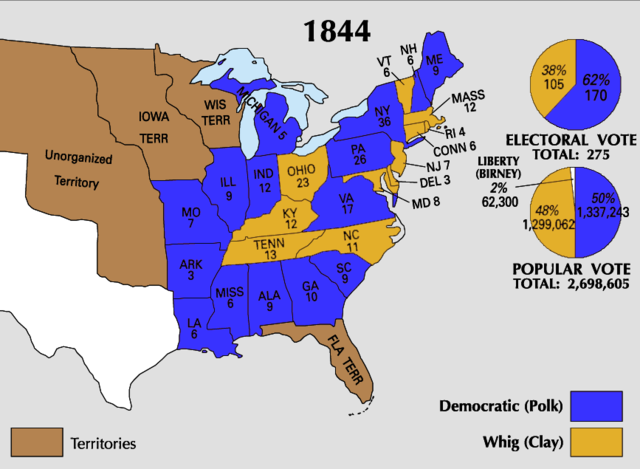
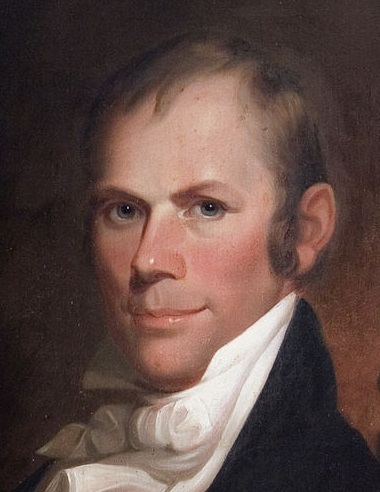
Henry Clay – Whig
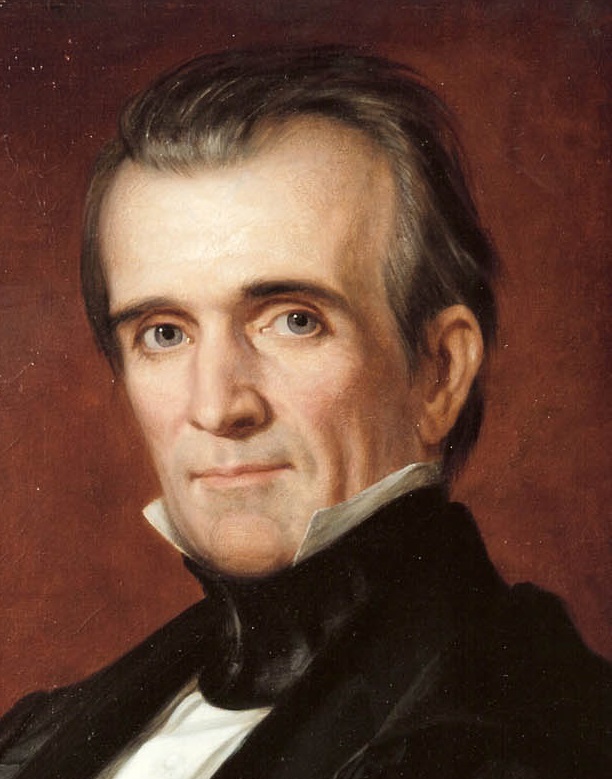
James Polk – Democrat
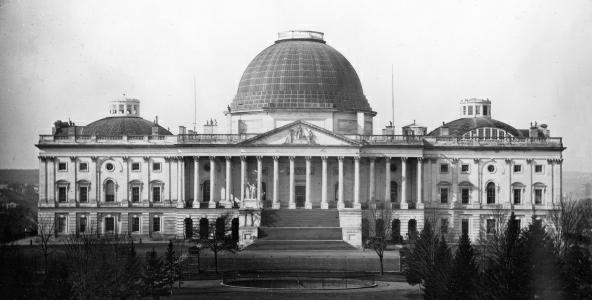
The U.S. Capitol – 1846
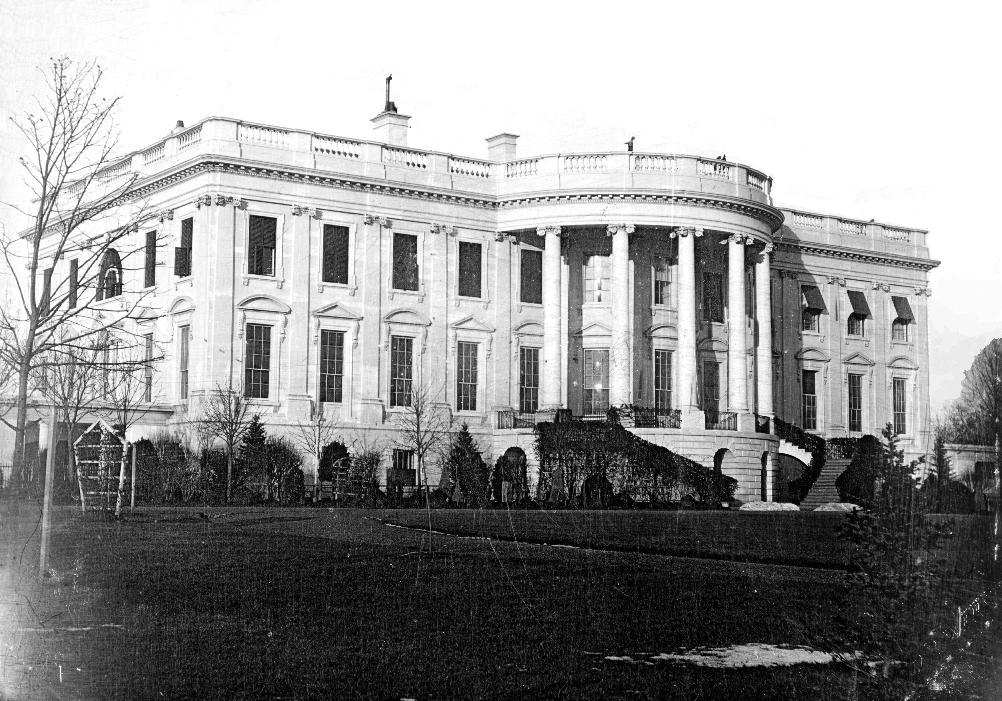
The White House – 1846
THE
MEXICAN-AMERICAN WAR (1846-1848) |
|
The admission of Texas to the Union
But as a lame-duck president, Tyler, sensing that
the election had served as a referendum strongly supportive of the
admission of Texas as a new state, moved ahead in his last days in
office as president and proposed to Congress a resolution opening Texas
to membership in the Union. This was the final blow in undercutting his
Whig political base, causing the president to be expelled from his own
Whig party!
The Whigs fought the annexation with all
the strength they could muster. John Quincy Adams, who as a strong
anti-slavery voice in the House of Representatives had opposed bitterly
the admission of Texas as a new slave state, voiced this move as being
a devastating calamity for the Union. But like the Federalists before
them, the Whigs were up against a growing Manifest Destiny fever which
seized the country. Remembering the fate of the Federalists, they
voiced their opposition carefully.
But Whig opposition would not be enough
to stop the entrance into the Union of another, quite large, slave
state. Ultimately Tyler succeeded in getting Congress to authorize the
annexation of Texas, not by a treaty requiring a 2/3rds vote for Senate
approval (which would not have been possible due to the strong Whig
opposition) but instead by a mere joint resolution of both houses of
Congress, which required only a simple majority in both houses! Finally
the resolution providing for the annexation of Texas was signed into
law by Tyler on his last day in office.
And his presidential successor, James
Polk, would see the annexation completed when the huge slave state
Texas formally accepted the invitation to join the United States in
December of 1845 as its 28th state.
Steps toward the Mexican-American War.
Mexico had made it clear that it would
never accept the loss of its Texas province, particularly if it were
then absorbed into the United States. Then when the discussions between
the Republic of Texas and the United States started referencing as
Texas's southern border with Mexico not the Nueces River but the Rio
Grande – much further south and thus deeper into Mexico – the Mexicans
were outraged.
In many ways the new president, James
Polk, was something of another Andrew Jackson: a strong personality who
was unafraid of stepping on toes in order to get done exactly what he
wanted. He also knew that Mexico was furious enough over the admission
of Texas to the Union that war could easily develop between the two
nations. He was prepared for that possibility as well.
But also Polk was by every instinct the
lawyer who believed that it was better to work out a deal with
litigants than go to court. By those same instincts he was hoping he
could work out a deal with Mexico, perhaps purchase his way to a
settlement. He was prepared to offer Mexico millions in assistance and
even in purchase of Western territory itself.
He knew of course that the Mexicans
themselves were fired up for war and wanted satisfaction for their
bruised sense of honor. Money would not restore that sense of honor.
Americans themselves were also getting fired up for war. Thus war was
likely. But Polk wanted to make sure that if and when it occurred, it
would take place on America's terms, not Mexico's.
The situation was complicated further by
the fact that relations between the Americans and the British were
quite unresolved in the far West. The British claimed Canadian
territory along the Pacific Coast deep into the Oregon region. There
were rumors circulating that the British were interested even in
extending their imperial hold all the way into California and were
thinking about purchasing sparsely inhabited California from Mexico.
The Mexicans were possibly considering this as preferable to having as
northern neighbors more Americans, who also were eying that land. Thus
some kind of Mexican-English relationship was possibly building which
would have weakened the American hand considerably in any war with
Mexico.
Furthermore, though humiliated in the
Texas war of Independence, the Mexican military was considered to be no
joke of an army. European military experts in fact expected that in any
direct military confrontation with America, the Mexican army, huge and
well disciplined, would make quick work of the motley crew of American
militia and the rather small national army. Indeed, many were certain
that the superior Mexican army would quickly roll back the Americans
all the way to Washington, D.C.
Seeing the war clouds darken, in mid–1845
Polk ordered General Zachary Taylor to move American troops into Texas
and position them on the Nueces River, waiting to see what might
develop. He also sent a small military group (sixty men) of explorers
under General John Frémont to Oregon through California (still part of
Mexico), whose larger purpose was a mystery to the Mexicans. Highly
suspicious of Frémont, the Mexicans ordered him out of California.
Then in early 1846 Polk sent an offer to
Mexico to purchase California and New Mexico. He also in April ordered
an American warship to move into the San Francisco Bay to protect
Americans living in California.
Meanwhile Mexico itself was undergoing
tremendous political turmoil (4 different individuals succeeded each
other in the Mexican presidency in 1846, 6 in the war ministry and 16
in the finance ministry). A big part of the problem was that the
Mexican leaders themselves could not agree on what to do in the face of
the growing possibility of war with America. Centralists demanded war;
Federalists requested negotiations. Back and forth the controversy
swayed, until the military party of Centralists seemed to have grabbed
firm control.
War is declared (May 11, 1846).
Polk then ordered Taylor to move his
troops all the way to the Rio Grande, where Taylor constructed a fort.
For the Mexicans this was the final insult, as they still claimed the
land south of the Nueces River and north of the Rio Grande as theirs.
In late April of 1846 they issued a declaration of intent to fight a
defensive war and sent a detachment of 2,000 Mexican soldiers to expel
the Americans from what they considered Mexican territory.
In the process, the Mexicans overwhelmed
a small patrol of seventy American soldiers in the disputed territory,
killing sixteen of the Americans. On May 11th, claiming that Mexico had
killed American soldiers on American soil (for that was the American
view on the matter of the territorial boundary), Polk asked Congress
for a declaration of war. The Democrat-dominated Congress obliged him –
though the Whigs, seeing this as playing to the advantage of the
Southern slave states, were highly opposed to this decision.
Action in Texas actually had taken place
even before the American declaration of War. Mexican and American
armies had met at the Rio Grande earlier in May, and the results were
disastrous for the Mexicans. From then on, the southern front in the
war would be fought in Mexico, not Texas.
California was next to become the scene
of battle. In June of 1846 Frémont returned to California to openly
invite a revolt (the Bear Flag Revolt) of Americans in Sonoma (northern
California). This all looked quite similar in character to the Texas
rebellion ten years earlier, except that the Californians moved
immediately to replace the California Bear Flag with the American flag.
Frémont's army moved south to capture Los Angeles, and was joined by
the army of American General Stephen Kearny, moving in from the East
across the vast southwest desert, who easily took San Diego. By January
of the following year (1847) the Mexicans were forced to surrender
their claim to California. England, meanwhile, had elected to stay out
of the conflict.
In the meantime, Taylor began to advance
his troops into Mexico from the northeast. His troops were a wild
collection of volunteers, undisciplined, and at times functioning more
like a drunken mob than an army (raping and pillaging as they went). It
took considerable effort for Taylor to finally be able to shape his gringos1 into a disciplined army.
Taylor's first major encounter with the
Mexicans was at the city of Monterey (September 1846) where his army,
unused to urban warfare, ran into stiff resistance from Monterey's
troops and citizens. Ultimately to achieve a win, Taylor had to resort
to an armistice allowing the Mexican soldiers to leave the city
peacefully. Technically this marked an American victory. But Polk was
furious about such a weak showing by Taylor.
Meanwhile Santa Anna had again seized control of the Mexican government
and had come out to fight the Americans. In February of 1847 Taylor's
and Santa Anna's armies met at Buena Vista – with the Mexican army over
three times the size of the American army. Santa Anna was able to
surround Taylor's troops and inflict huge casualties on them, though
the Americans held their position. Both sides were exhausted. But Santa
Anna got news of political troubles back in Mexico City and had to
abandon the conflict, leaving Taylor in control.2
During all of this confusion the Comanche
and Apache Indians had been conducting raids on the Mexicans. Thus as
American soldiers advanced from the northwest toward Mexico City, they
found the countryside deserted and the towns unwilling to resist the
advancing Americans.
At the same time, Americans under naval
Commodore Matthew Perry were fighting the Mexicans along the Mexican
shores and tributary rivers of the Gulf of Mexico, inflicting
humiliating defeats on the Mexicans as they went.
Polk now turned to General Winfield Scott
(working closely with Perry) to lead an assault in March of 1847 on the
Gulf of Mexico coastal town of Vera Cruz, to reduce the walls
protecting the city in preparation for a massive amphibious landing of
American troops whose ultimate destination would be Mexico City.
Seriously outnumbered by this attacking American force, the Mexicans
were only able to hold out a dozen days before having to surrender Vera
Cruz to their American attackers.
The Americans then headed west to Mexico
City and, after overcoming stiff resistance to the north of the city at
Chapultepec (including the brave fighting of the Mexican students at
the military academy located there), were able to enter the city in
mid-September. Santa Anna was overthrown and fled the country. The
Americans were now in total control of the Mexican political heartland.3
The question then arose: what to do with
Mexico? Some political voices speculated that the Mexicans themselves
might greet annexation to the United States gladly. The Whigs were
however strongly opposed to the annexation of Mexican territory,
fearing it would only expand the political weight of the pro-slavery
portion of the nation. But in fact, neither the Mexicans nor most
Americans had any interest themselves in such a union.
1There is some dispute about the origins of the term gringo. Some claim that it originated from the song that the Americans sang, "Green Grow the Lilacs," as they marched through Mexico!
2Taylor would make much of this victory in his successful bid for the U.S. presidency in 1848.
3Marines
were put on guard duty at the Mexican National Palace, the "Halls of
Montezuma," completing the opening line of the Marine's hymn: "From the
Halls of Montezuma to the shores of Tripoli..." [from Mexico City to
the shores of the Barbary Pirates].
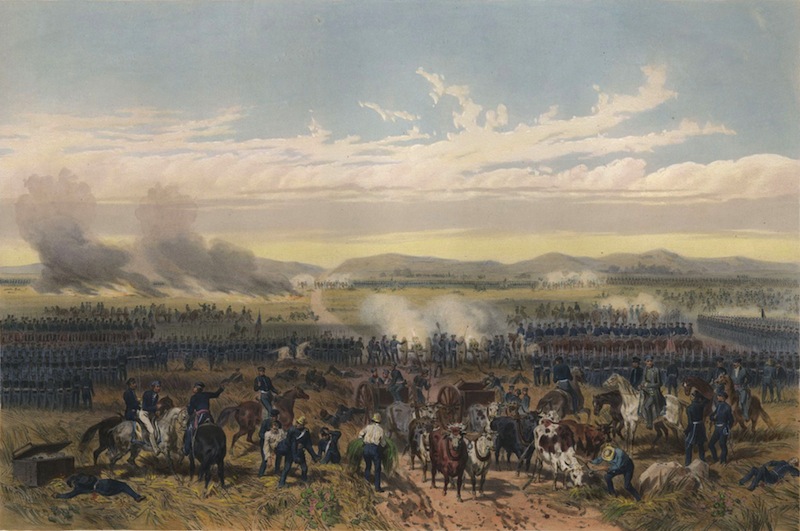
The Battle of Palo Alto (May 9, 1846) fought in the region between the Nueces River in the North (Mexico's understanding of the Mexican-Texas border) and the Rio Grande (the American view on where the border lay). About 2,200 U.S. forces under Zachary Taylor took on General Arista's force of 3,700 in which American artillery devastated the Mexican army.
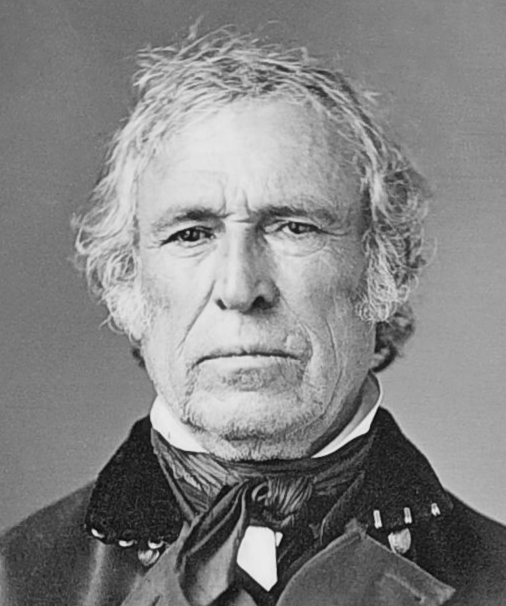
General Zachary Taylor

John C. Frémont

Stephen Kearny
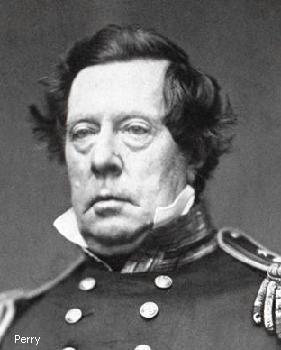
Commodore Matthew Perry
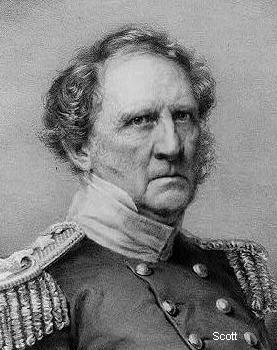
General Winfield Scott
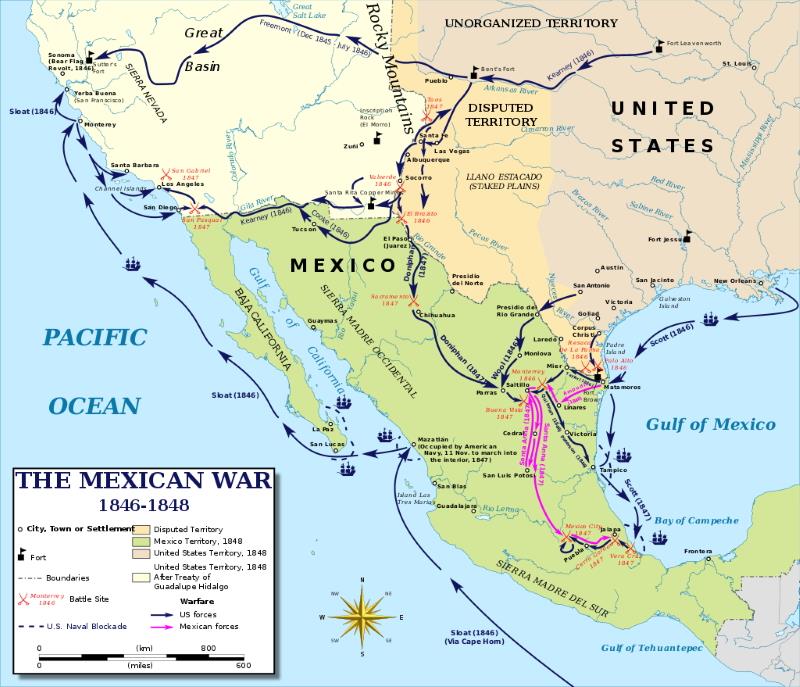
Charles O. Paullin and John K. Wright's Atlas of
the Historical Geography of the United States (1932)
Wikipedia

Commodore John Sloat's forces take Monterrey (July 7, 1846)
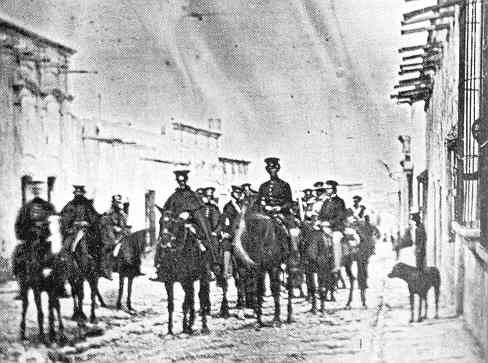
February 1847 – U.S. troops under Zachary Taylor entering Saltillo (an early
photograph)
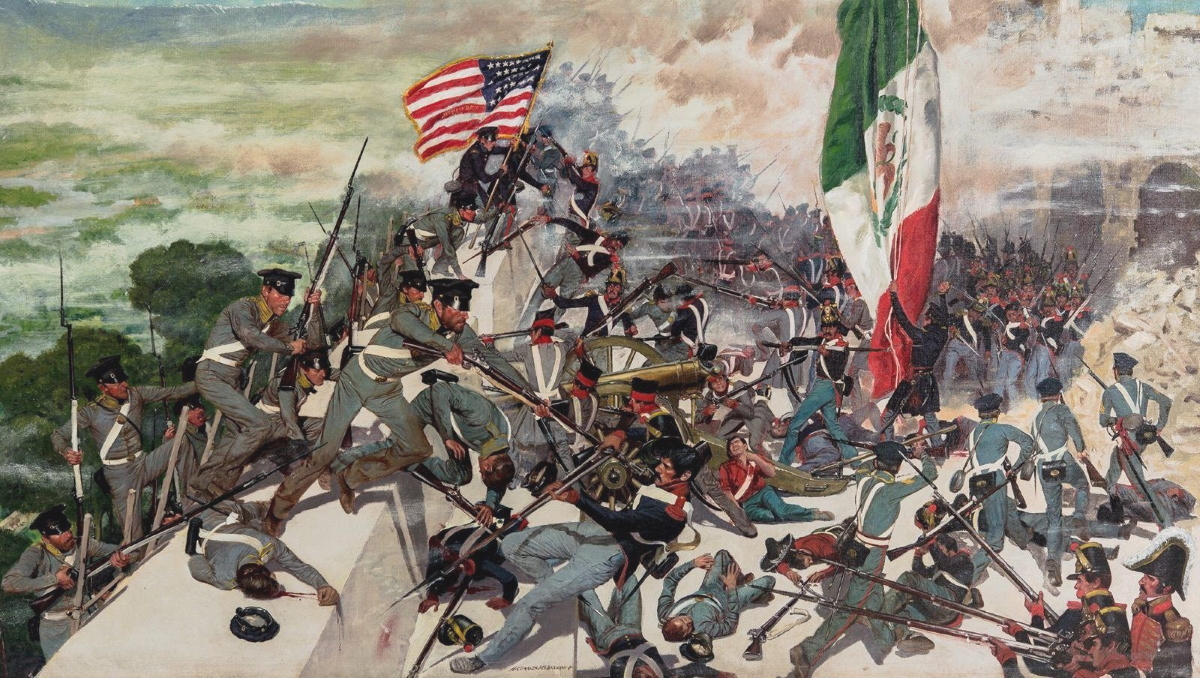
Americans attack the Mexican position at Chapultepec (September 13, 1847). With Santa Anna fleeing, at this point the Americans were in full control of Mexico
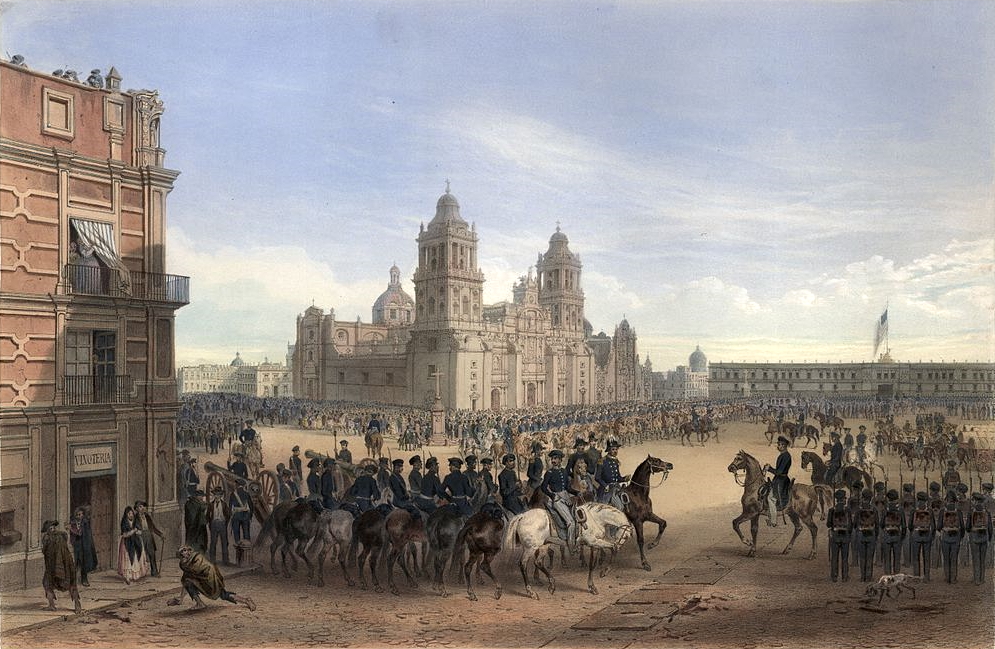
General Scott takes command of Mexico City
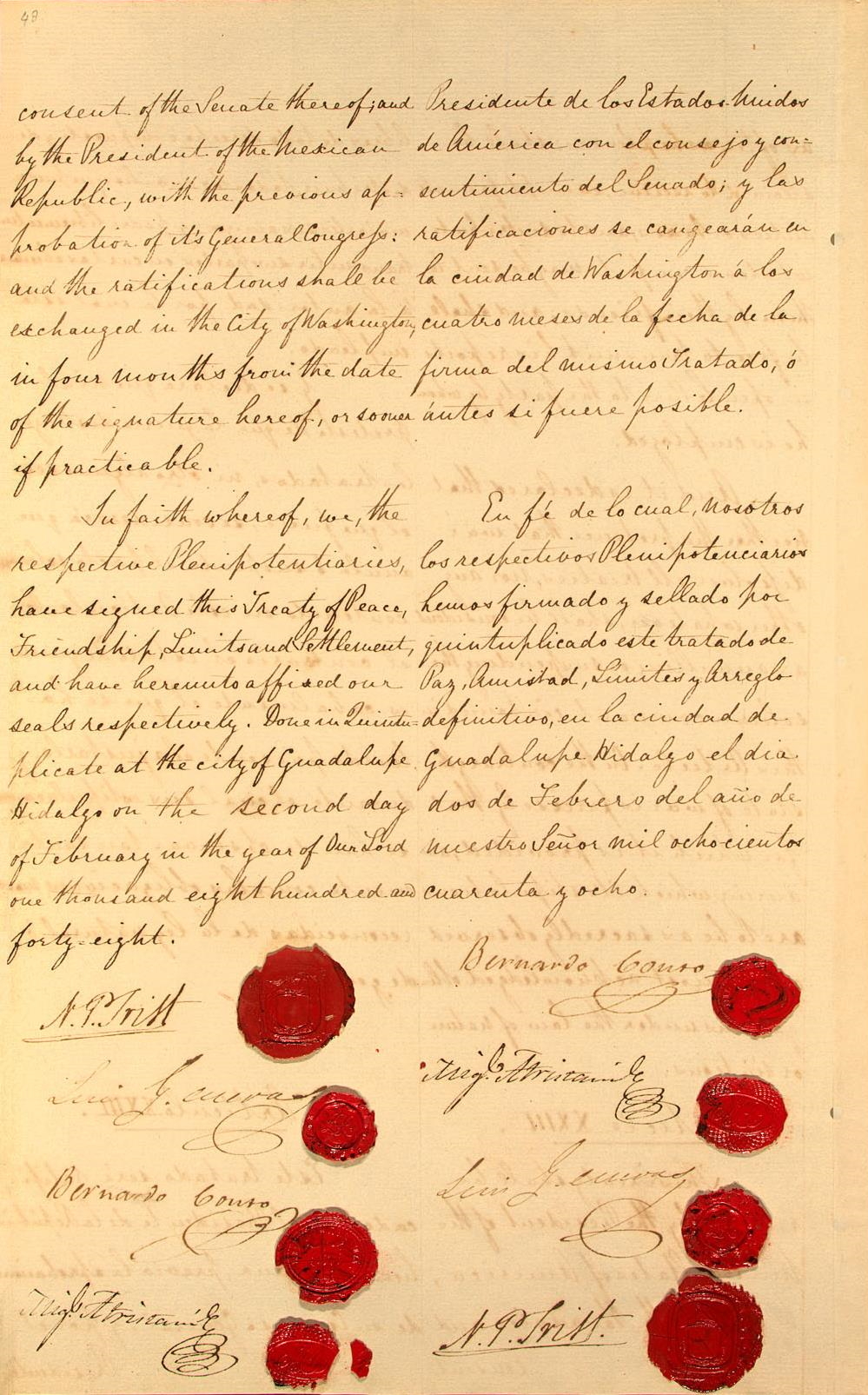
The Treaty of Guadalupe-Hidalgo (February 2, 1848)
awarding Mexico $15 million for the territory lost to the United States
THE MORAL IMPACT OF THE MEXICAN-AMERICAN WAR |
|
Many of the Whigs of the American North had viewed
the Mexican-American War as little more than an effort of the South to
strengthen its political position in Congress by adding newly conquered
territories, and thus subsequently future states, to the pro-slavery
roster. Most notable in their opposition to the Mexican-American War in
this regard had been Henry Clay and John Quincy Adams. They employed
every argument possible concerning the moral degeneracy of the
imperialism America had inflicted on its Mexican neighbors. However
most Whigs certainly encouraged the idea of American expansion westward
– as long as any newly acquired territories remained in the Free-Soil
category.
Then in August of 1846, during the debate
approving the $2 million in appropriations underwriting potential
negotiations with Mexico (which it was hoped at the time might end the
war) the gauntlet was thrown down in Congress by Representative David
Wilmot. He wanted attached to the appropriations bill the proviso that
would ban slavery in any of the lands that the Mexicans might turn over
to the Americans (the Mexican Cession) as a result of a much hoped-for
negotiated peace settlement. The bill passed in the House, but failed
in the Senate when Congress dismissed without considering the
resolution. When Polk later that year made another request for funds to
negotiate a peace settlement with Mexico the Wilmot Proviso was
reintroduced and hotly debated. However as debate developed, an
additional demand was added the following year that the prohibition of
slavery be extended to any new territory acquired by the United States.
Tempers were now hot.
Then Alabama Representatives proposed a
counter-resolution which would leave the slavery issue to the
individual territories to decide (building on the philosophy of the
sovereignty of the states, or states' rights). The measure failed to
pass, but united the Southern representatives into a strong regional
bond, one that would build and become the main political identifier
among the members of Congress.
America's major political division now followed not the more
traditional Whig/Democratic Party lines, but ominously North/South
regional lines. The parties themselves were splitting into North-South
factions, especially as the Wilmot Proviso kept getting introduced time
and again in the North's hope of finally forcing the end of slavery on
the South.
Finally, with the American military
victory in Mexico City, negotiations got underway in January of 1848 at
the town of Guadalupe Hidalgo, and within a month the two sides agreed
on terms: Mexico would receive $15 million in payment from America for
the acquisition of California, Texas to the Rio Grande, and the
territory in between (which would eventually become New Mexico, Arizona
and Utah.)
John Quincy Adams' death,
and the finalizing of the Guadalupe Hidalgo Treaty
When the Guadalupe Hidalgo Treaty was
submitted to the Senate for ratification in February, the Whigs were
bitterly opposed to any affirmation of the Mexican-American War and its
outcome because of the blatant imperialism involved. Even with the
revealing of the generous terms offered to and accepted by Mexico in
the negotiations of 1848, a storm erupted. Certainly the generosity
undercut some of the imperialist argument, though others were appalled
at just that generosity. But mostly the eruption occurred over the idea
of a number of potentially new states in the Southwest being lined up
for statehood and how this would tip the balance in the growing
North-South split over slavery. Leading the attack on the treaty was
the distinguished Whig senator from Massachusetts, Daniel Webster, the
Great Orator.
Then in the middle of discussions going
on in the House, John Quincy Adams was felled by a heart attack,
bringing the proceedings to a halt over the next days as the nation
stood watch over the last man with personal connections with the
Republic's Founding Fathers, and who himself had come to grow greatly
in the esteem of his Congressional colleagues because of his cool wit
and sharp insights. When he died on the 23rd (of February) the nation
mourned.
The effect was to sober the proceedings
in the Senate, which in early March finally moved to approve the
Guadalupe Hidalgo Treaty, 38–14.
The size of the financial award offered
to Mexico for the loss of its territory still caused some to question
exactly who it was that had won, and who had exactly lost the war! But
it was a wise move, giving a degree of fairness to the war's outcome,
because Mexico might otherwise have continued to harbor a deep
resentment over a total loss – such that Mexico would have been tempted
to renew the war at a time when America was less able to fight, as
would have been the case when America fell into its savage Civil War
thirteen years later.
Adams
and Clay had been strong opponents of the war with Mexico ... seeing in
it only ugly imperialism. But in general the Whigs were
supportive of the war.
The Wilmot Proviso
Making
the situation even more complicated, in 1846 Pennsylvania
Representative David Wilmot attached his "proviso" on the bill
authorizing payment to Mexico for their loss of Western land ...
requiring any territory acquired in the war be automatically "Free
Soil" (no slavery). Tempers now got very hot.
|
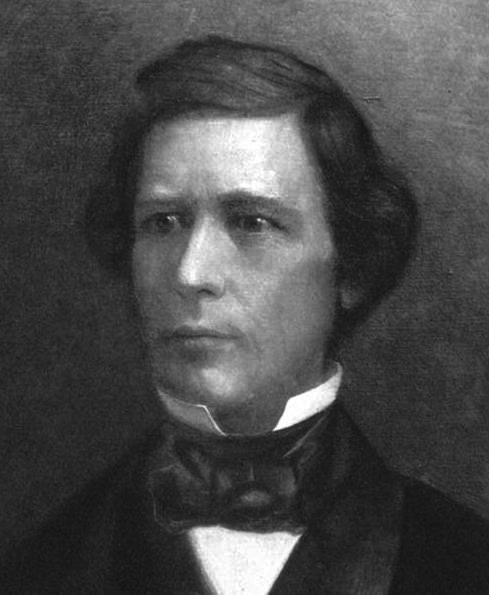
David Wilmot
| Then
with Adam's death in 1848 ... Senator Daniel Webster of Massachusetts
took up the anti-imperialist role as the leading opponent of the
Guadalupe Hidalgo Treaty finalizing Mexico's territorial loss (but
financial gain) in the West
|
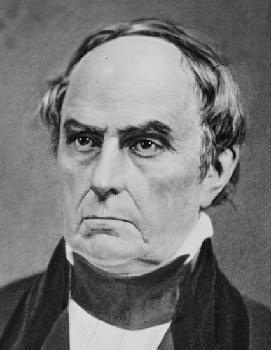 Daniel Webster
Daniel Webster

Go on to the next section: "Westward Ho!"
 Miles
H. Hodges Miles
H. Hodges
| | | | |

 The 1844 elections
The 1844 elections
 The Mexican-American War
The Mexican-American War The moral impact of the Mexican-
The moral impact of the Mexican-



















